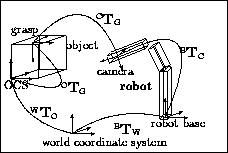


Previous: Results Up: 3D-Modeling for the Analysis of Range Next: Summary



The modeling conception presented above was developed as a part of a 3D robot sensor system. The complete system is described in [19] [17]. But it is not restricted to this system, it should work with any kind of range data and most recognition strategies. So the following is just an example how the model can be used.

The 3D robot sensor allows the generation of range images of a scene on request. Therefore the camera is attached to the gripper of a robot.
Recognition and pose estimation are based on local constellations of geometric scene primitives as described above. They are matched against corresponding structures in the model. As the number of comparisons which are necessary for this process is very large, it is urgent to optimize the efficiency of this operation.
The whole recognition process is controlled by a hypothesis generation/hypothesis verification scheme [13] [11]. After analysis of a first image, there may be multiple hypotheses for one object. To choose the right one it may e.g. be necessary to see the back of the object. As the camera is attached to a robot (Figure 14), it is possible to acquire additional views of the scene. Many problems with 2 1/2 dimensional data can be solved in this way, especially in industrial environments.


